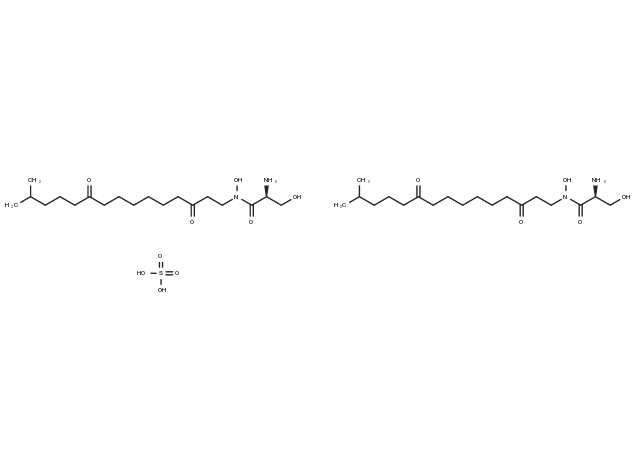Powder: -20°C for 3 years | In solvent: -80°C for 1 year


Lipoxamycin hemisulfate (Lipoxamycin) is an inhibitor of serine palmitoyltransferase (IC50 = 21 nM) with antifungal activity.

| Pack Size | Availability | Price/USD | Quantity |
|---|---|---|---|
| 1 mg | In stock | $ 245.00 | |
| 2 mg | In stock | $ 365.00 | |
| 5 mg | In stock | $ 616.00 | |
| 10 mg | In stock | $ 877.00 | |
| 25 mg | In stock | $ 1,320.00 | |
| 50 mg | In stock | $ 1,790.00 | |
| 100 mg | In stock | $ 2,390.00 |


| Description | Lipoxamycin hemisulfate (Lipoxamycin) is an inhibitor of serine palmitoyltransferase (IC50 = 21 nM) with antifungal activity. |
| In vitro | Lipoxamycin hemisulfate shows antifungal activity against a panel of human pathogenic fungi with better potency against some of the Candida species (MIC = 0.25-16 µg/mL)[1]. |
| In vivo | In Chinese hamster ovary cell mutant, Lipoxamycin hemisulfate is highly toxic in mice when applied subeutaneously or topically[1]. |
| Synonyms | Lipoxamycin, sulfate (2:1), U-26146D, U26146D, U 26146D, Lipoxamycin |
| Molecular Weight | 843.08 |
| Formula | C38H74N4O14S |
| CAS No. | 11075-87-9 |
Powder: -20°C for 3 years | In solvent: -80°C for 1 year
DMSO: 36 mg/mL (42.7 mM), Sonication and heating to 60℃ are recommended.
You can also refer to dose conversion for different animals. More
bottom
Please see Inhibitor Handling Instructions for more frequently ask questions. Topics include: how to prepare stock solutions, how to store products, and cautions on cell-based assays & animal experiments, etc.
Lipoxamycin hemisulfate 11075-87-9 Microbiology/Virology Antifungal 2:1 Lipoxamycin, sulfate (2:1) Lipoxamycin, Sulfate Lipoxamycin Hemisulfate U-26146D U26146D U 26146D Lipoxamycin inhibitor inhibit
